 |
Astronomy 101 Problem Set #1 Solutions | 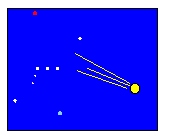 |
 |
Astronomy 101 Problem Set #1 Solutions |  |
Problem #1: Some of the oldest Moon rocks found by the Apollo missions are estimated to be about 4.45 billion years old. Calculate their age in seconds, and express the result in scientific notation (Use the relation 1 year = 365.25 days).
Solution: The tricky part about most problems usually lies in figuring out how to apply what you already know to the problem at hand. In this case, we know lots of conversions between units of time (how many seconds in a minute, for example), but we don't know the requested conversion. So, let's start by writing down the conversions we know:
The last conversion is certainly correct, but it probably won't help us solve the problem at hand.
Now let's try to solve the problem in parts. We already know that 1 day = 24 hours, so how many hours are in 365.25 days ( = 1 year)?
For the next step, we do exactly the same thing, only this time, we make use of our knowledge of the conversion from hours to minutes. If there are 60 minutes in 1 hour, how many minutes are in 8766 hours?
The last step is yet another repeat of the same process, using our knowledge of the conversion from minutes to seconds. If there are 60 seconds in a minute, how many seconds are in 525,960 minutes?
Now, to finish it off, we multiply the number of seconds in a year by the number of years in the age of the oldest Moon rocks.
However, we're still not finished here. The last step of this part is to express our answer with the appropriate number of significant digits. Since you were given the age of the oldest Moon rocks as 4.45 x 109 years, and not 4.4 x 109 years or 4.4537809 x 109 years, we should assume that this number is only accurate to three significant digits. That is, the age of the oldest Moon rocks is somewhere between 4.445 x 109 years and 4.455 x 109 years old. Well, our translation of the age from years to seconds certainly hasn't added any accuracy to the result, so the answer should still be expressed with only three significant digits. The easiest way to do this is to just to truncate our decimal number from 1.4043 to 1.40.
So, our final answer is
1.40 x 1017 seconds
Problem #2: For many of you, the metric system is fairly unfamiliar. Since ALL of science (and most commerce outside the US) makes use of the metric system, it would be a really good idea for you to have some comfort with the units. With that in mind, let's consider a few familiar objects and activities. For each question below, estimate the answer, and express that answer in metric units.
Solution: For this problem, you'll likely come up with different answers, since you're not all the same height as me, and many of you probably drive pretty fast on the highways. Therefore, the grading on this problem reflects more about how you did the calculations, rather than the actual result. I'm 5 feet 11 inches tall, or a total of 71 inches. To express this height in metric units, we'll need to convert. In order to convert units correctly, all you need to do is to multiply by 1, but a special form of 1. Recall that 1 can be written as 2/2, 10/10, or any number over itself. Basically, if the top and the bottom of the fraction are the same, then the fraction is a "1." Recall also that when you multiply anything by 1, you get back the same thing, i.e., 10 x 1 = 10, 242 x 1 = 242.
So we're just going to multiply my height by 1 in order to convert the units. Because we're multiplying by 1, we're not changing the measurement, and that's important. The distance is the same whether it's measured in inches, feet, or miles -- it's just the number out front that changes.
However, if we choose our "1" cleverly, we can end up changing the
units of my height. That's because "1" is nothing more than a
fraction where the top and bottom are the same thing, ie.,
This may seem like a long and painful way to convert units, but if you do it this way, you'll never make the mistake of dividing instead of multiplying, and you'll never make a conversion error. If you just try to remember whether to multiply or divide, I guarantee you'll get it wrong about half the time. Just remember, when converting, always multiply, and always multiply by 1.
OK, I live about 2 miles away from the LC, so I need to convert this distance into metric units as well. Using the conversion I find on the back of the book, I make a "1" and multiply it by this distance as follows:
How fast do I walk? I don't really know off-hand, so I measured it. I found a hallway that was 25 feet long, and timed how long it took to walk down it. Walking with a normal pace, I found it took 5 seconds to cover this distance. So that mean my speed is
How fast do I drive on the highway? Well, truth be told, just like Sammy Hagar, I can't drive 55. So usually, I drive between 65 and 70 mph (a.k.a. miles/hour) on the intersate. For this problem, I'll say 68 miles/hour. To convert this to metric units, I need to change the mile unit to km, but I can leave the hour unit alone (metric units for time are the same as English units for time -- seconds, minutes, hours). So,
I really hope none of your parents are state troopers.
Problem #3: It is claimed that Superman is faster than a speeding bullet. A speeding bullet has a speed of about 700 m/s, so let's assume Superman can fly at 1000 m/s. At this speed, how long would it take him to circle the Earth, a trip of approximately 40,000 kilometers? How long would it take Superman to travel to the Moon, a distance nearly ten times greater? Express your answer in hours.
Solution: This problem looks quite easy (and is), but it contains a couple of time bombs which need to be addressed. The first one is the units of the quantities you are given. You have a speed in meters per second (m/s) and a distance in kilometers (km). These quantities cannot be used together until they in the same base units, so you'll have to convert Superman's speed from m/s to km/s or convert the distance he travels from km to m. I'll choose to convert the distance he travels.
nce again, we'll choose a useful form for "1":
OK, now we have the distance Superman travels in the right units, and his speed. His speed is 1000 m/s, so how far does he travel in one second? 1000 m, of course. How about in 2 seconds? 2000 m. How about in n seconds, where n is some number we don't yet know? He'll travel 1000 m/s x n s = 1000 x n m.
OK, so we know how far Superman travels and we want to find out how many seconds it takes him, so let's just say that it takes n seconds, and then figure out what n is later.
Now, if Superman needs to get to the Moon, he'll have to travel about ten times farther. That means, instead of 11 hours, it'll take him 110 hours, or nearly five days. The Apollo astronauts made it in three, so they traveled even faster than Superman.
Problem #4: On September 21 or thereabouts, the Sun is positioned directly over the earth's equator. That is, were you to stand on the equator at noon on this day, the Sun would be directly over your head. What is the elevation of the Sun above the southern horizon here in Lewisburg (e.g., 41 degrees north latitude), at noontime on that day? (To answer this question, please draw a diagram of the Earth indicating the positions of equator and Lewisburg, the horizons at these locations, and the sunward direction from each of these locations. Then show the geometrical relations you use to derive a numerical answer.)
Solution: This is a geometrical problem and is relatively straightforward to solve if you draw the right diagram. So let's start by drawing a cutaway model of the earth, labeling the Equator and North Pole:
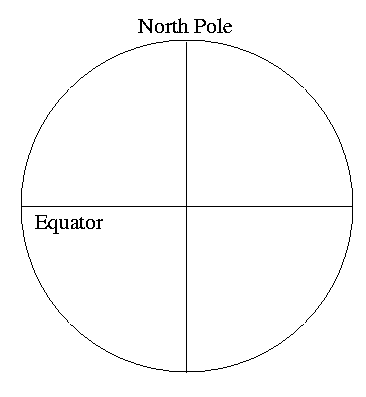
Now construct a line in the vertical direction form the earth's surface at the Equator. Remember that a vertical line points directly away from the center of the Earth. Once you've put in the vertical line, drawing the horizon is easy, since the horizon is always perpendicular to the vertical.
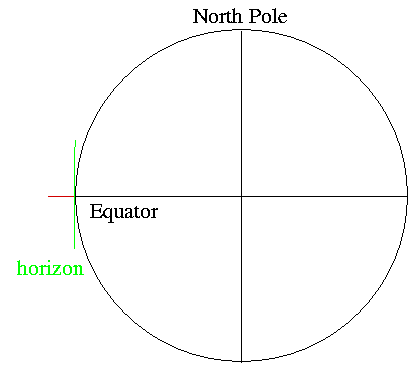
We're told the the Sun is directly overhead when viewed from the Equator on 21 March, and since we have a line indicating the vertical direction at the Equator, it's pretty easy to figure out the direction to the Sun
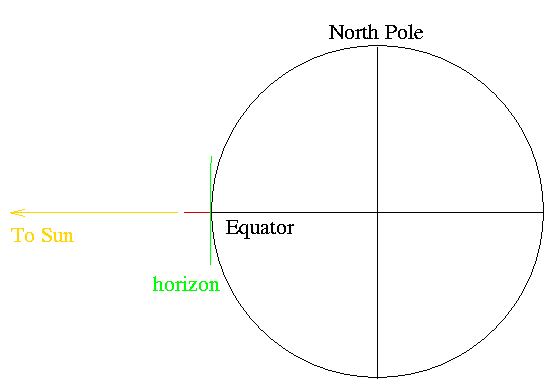
OK, we've taken care of the Equator part of the drawing. Now we need to put in Lewisburg. We're told that Lewisburg is at a latitude of 41 degrees north. That tells us how far around the spherical earth Lewisburg is. Draw a line from the center of the earth at an angle of 41 degrees to the line to the Equator (since the Equator is at 0 degrees latitude). Lewisburg is located where this line reaches the earth's surface.
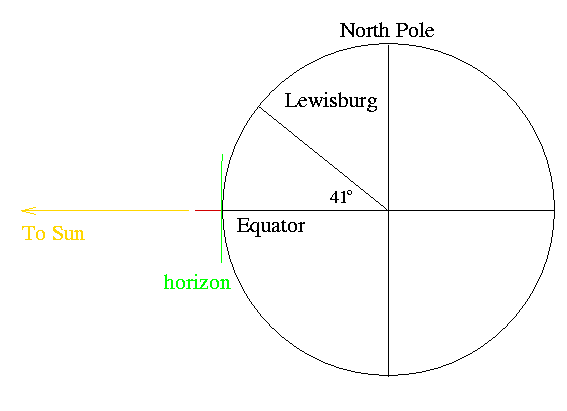
Now we can construct vertical and horizon lines just as we did at the Equator (but remember: vertical lines point directly away from the center of the earth!)
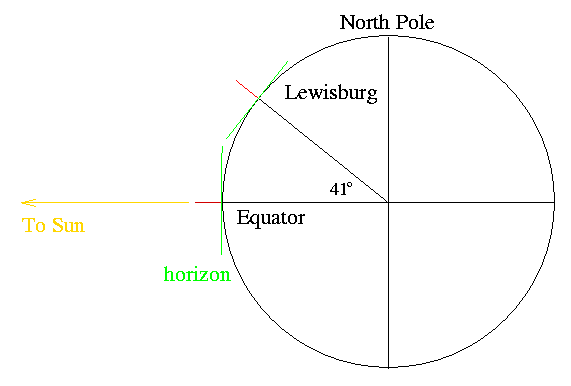
The last bit is to figure out the direction to the Sun from Lewisburg. Recall that the Sun is really far away (more than 12 million earth diameters away), and because it's so far away, the rays reaching Lewisburg are parallel to the rays reaching the Equator. That makes it easy to draw in the sunward direction at Lewisburg, since it is parallel to the sunward direction at the Equator:
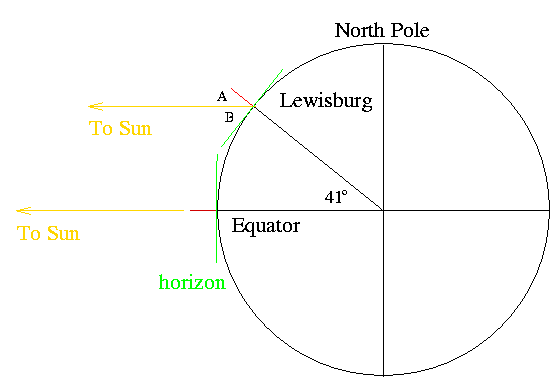
and we've finished the diagram, which really was the hard part of the problem. The rest is really pretty straightforward, provided you remember some rules about angles. The first one is that a line crossing two parallel lines makes the same angle with each of the parallel lines. We can use that relation here, since the sunward lines at both locations are parallel. Therefore, the angle labeled ``A'' in the above diagram must be equal to the angle labeled 41o at the center of the earth. We know that the angle between the vertical (red line) and the horizon (green line) is 90 degrees, and we know that angle ``A'' is 41 degrees, so angle ``B'' must be
Elevation of the Sun above the southern horizon on 21 March at noon = 49 degrees
